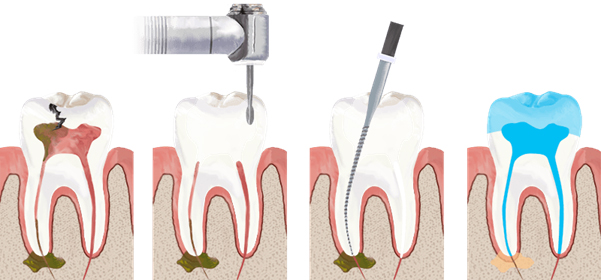A root canal procedure is performed either when the nerves within the tooth have become inflamed due to decay, a deep filling or a crack. If the symptoms of one of these is ignored it will lead to the nerve dying and becoming infected. This results in the formation of an abscess (a sack of pus) at the tip of the root of the tooth. Severe pain and swelling will then occur.

Root canal symptoms
The symptoms to look out for initially are if your tooth becomes very sensitive to cold/hot and tenderness to biting. This Pain is usually sharp and does not last for long. If the nerves in your tooth are already dead, then the pain is more likely to be a prolonged ache and particularly brought on by hot drinks and food. The success of a root canal treatment is higher if you have it treated earlier, before it turns into an abscess.
How long does a root canal take?
Every tooth has a different number of nerves which run through a canal. Generally the back teeth have more canals than the front teeth. The number of appointments is also dependant on whether the tooth is in the early stages of decline or is at the abscess stage. Root canal procedures on the back teeth, which usually have 3 canals, normally takes 1 hour for the first appointment and 45minutes for the second appointment, but it is highly variable from case to case.

Pain after root canal treatment
Mild healing pain is normal for 1-3 days after a root canal procedure however it is generally very minuscule in comparison to the pain being experienced by the patient when they initially come in for the appointment.

Root canal treatment steps
1. It the patient is in pain the nerve chamber is accessed from the top of the tooth, under anaesthetic of course, and a pain relieving medicine is placed within the canals. If the patient has swelling and infection then antibiotics may also be prescribed.
2. Second visit involves removing the infection from within the canals of the tooth and irrigation with an anti-bacterial liquid.
3. Thirdly the canals are filled with a rubber material to prevent any further spread of bacteria.
4. Lastly a filling is placed over the access hole. If the root canal is performed on a back tooth, either a premolar or molar tooth, a crown is commonly needed to strengthen the tooth and prevent it from cracking in the future.

Root canal treatment side effects.
The main side effect of root canal therapy is the removal of a tooth ache and possible infection formation. There is always the potential for reinfection if a mystery canal is not found or the tooth has unusual anatomy. However our Dentists at Terrigal Beach Dental take great pride in their work and will ensure that the best possible outcome is achieved.

